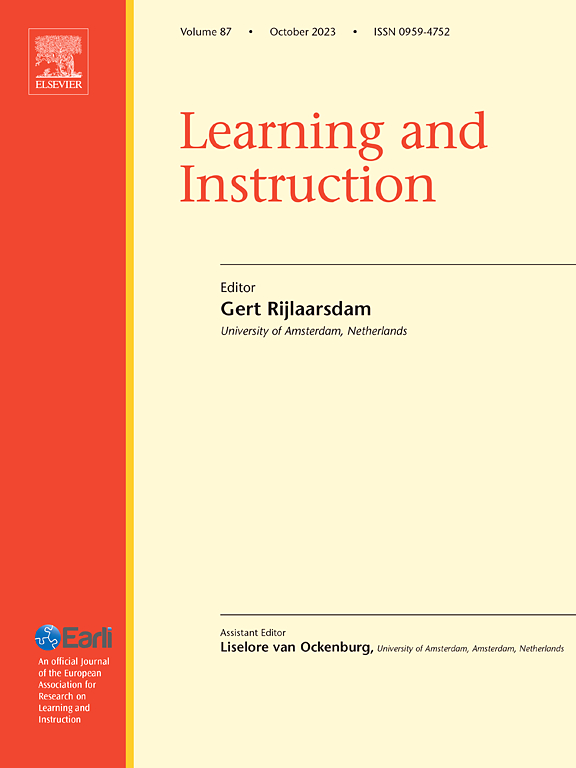基于数量级的推理可以在比较分数时减少自然数偏差:一项干预研究
IF 4.9
1区 教育学
Q1 EDUCATION & EDUCATIONAL RESEARCH
引用次数: 0
摘要
在比较分数时,学生通常关注的是自然数成分,而不是分数的数值(例如,他们认为2/4 >;1/2因为2 >;1和4 >;这种现象被称为自然数偏差。迄今为止,关于减少这种偏见的方法的研究很少。目的研究分数大小推理能力的提高是否能提高学生分数比较的准确性,减少分数的自然数偏差。样本参与者是225名来自德国学术轨道中学的六年级学生。方法采用三组随机前测后测干预设计。在六周(18次)的时间里,干预组接受基于计算机的训练,将视觉表征与符号分数联系起来,以激活分数的大小。一个对照组使用不同的工具进行分数学习,不关注分数大小,而另一个对照组没有接受任何训练。结果干预组学生分数比较准确率平均提高15%(对照组分别提高3%和6%)。前测和后测结果揭示了分数对与naïve自然数推理一致或不一致的准确性的个体差异。在干预组中,74%在前测时表现出典型自然数偏差的学生在后测时不再表现出典型自然数偏差,这一比例高于两个对照组(分别为15%和22%)。结论学生对分数大小推理能力的提高降低了自然数偏倚,挑战了先前关于偏倚持续存在的研究。这些发现有助于讨论减少数学中有偏见的推理的有效方法。本文章由计算机程序翻译,如有差异,请以英文原文为准。
Magnitude-based reasoning can reduce the natural number bias when comparing fractions: An intervention study
Background
When comparing fractions, students often focus on the natural number components rather than on the fractions’ numerical values (e.g., they reason that 2/4 > 1/2 because 2 > 1 and 4 > 2). This phenomenon is known as natural number bias. To date, there has been little research on ways to reduce this bias.
Aims
We investigated whether an increased ability to reason about fraction magnitude can improve students’ accuracy and reduce the natural number bias when comparing fractions.
Sample
Participants were 225 sixth-grade students from German academic-track secondary schools.
Methods
We used a three-arm randomized pretest-posttest intervention design. For six weeks (18 sessions), the intervention group received computer-based training linking visual representations to symbolic fractions to activate fraction magnitude. One control group used a different tool for fraction learning that did not focus on fraction magnitude, while the other control group received no training.
Results
On average, students in the intervention group improved their fraction comparison accuracy by 15% (control groups: 3% and 6%, respectively). Pretest and posttest results revealed interindividual differences in accuracy for fraction pairs congruent or incongruent with naïve natural number-based reasoning. In the intervention group, 74% of students who showed a typical natural number bias at pretest no longer showed it at posttest, a higher percentage than for both control groups (15% and 22%, respectively).
Conclusions
Students’ increased ability to reason about fraction magnitude reduced the natural number bias, challenging previous research that the bias is persistent. The findings contribute to discussions about effective ways to reduce biased reasoning in mathematics.
求助全文
通过发布文献求助,成功后即可免费获取论文全文。
去求助
来源期刊

Learning and Instruction
Multiple-
CiteScore
11.30
自引率
4.80%
发文量
109
期刊介绍:
As an international, multi-disciplinary, peer-refereed journal, Learning and Instruction provides a platform for the publication of the most advanced scientific research in the areas of learning, development, instruction and teaching. The journal welcomes original empirical investigations. The papers may represent a variety of theoretical perspectives and different methodological approaches. They may refer to any age level, from infants to adults and to a diversity of learning and instructional settings, from laboratory experiments to field studies. The major criteria in the review and the selection process concern the significance of the contribution to the area of learning and instruction, and the rigor of the study.
 求助内容:
求助内容: 应助结果提醒方式:
应助结果提醒方式:


